
|
|

| Home | Milieu & Energie | Gezondheid & Wetenschap | Duurzaam Bouwen | Photo Gallery |
| Geologie & Reizen | Landbouw & Voeding | Natuurbescherming | Eilanden | Geo-educatie |
| Zon & Wind | Bouwen op Water | Architectuur |
|
Publicaties Milieu & Energie: Alle artikelen tot 2012 |
Artikelen Milieu & Energie 2016-2014 >> Artikelen Milieu & Energie 2013 >> Artikelen Milieu & Energie 2012 >> Artikelen Milieu & Energie tot 2012 >> |
|
Boeren op moderne terp 20 juni 2012 Lees online op Kennislink >> |
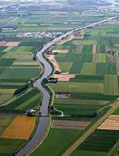
|
Intro: Nederland zal zich moeten voorbereiden op andere tijden. Door klimaatverandering wordt
in Noord-Europa lokaal extra regenval voorspeld, vooral in de winter. Als afvoersysteem
van de Alpen zal de Rijn hierdoor meer water te verwerken krijgen. Ook de Maas zal als ‘regenrivier’
miljoenen extra kubieke meters water moeten afvoeren. Omdat – ook door klimaatverandering – de zeespiegel
hoger komt te staan, krijgen rivieren het moeilijker het water te ‘dumpen’ in de Noordzee. Het is daarom
noodzakelijk de rivieren op bepaalde locaties te verbreden en dus ‘gecontroleerd’ te laten overstromen. Foto: Oude Maasje © Waterschap Brabantse Delta |
|
Nog veel ondiep gas te winnen 22 maart 2012 Lees online op Kennislink >> |
Intro: Het Groningen gasveld loopt langzaam leeg. Ook de kleinere gasvelden raken uitgeput. Als we niets doen zullen we in 2022 al netto-gasimporteur worden. Om het moment dat ons gasverbruik de binnenlandse productie overstijgt zo lang mogelijk uit te stellen, probeert Nederland de gaswinning uit de kleine gasvelden tot het jaar 2030 stabiel te houden op 30 miljard kuub per jaar (de '30/30-ambitie'). Alternatieve kleine gasbellen zoekt de olie- en gasindustrie in tight gas (moeilijk winbaar gas in dicht gesteente), stranded fields (gasvelden die slecht bereikbaar zijn of waar de infrastructuur ontbreekt), onconventioneel gas en in shallow gas fields in ondiepe zandafzettingen onder de Noordzeebodem. |
|
'Unconventionals are easy to find but hard to get' In: European Energy Review January 2012 Read online >> |
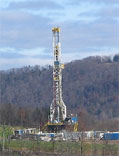
|
Intro:
Don't expect a US-style boom in shale gas production in Western Europe. It's still not proven
that economically viable reserves of shale gas even exist over here. Compared with North America,
the regions in Europe characterized by the necessary geological conditions for shale gas are scarce.
This is the opinion of Jan de Jager, newly appointed professor in Regional and Petroleum Geology at
the University of Utrecht, who before his appointment worked as exploration geologist for Shell
for over 30 years. De Jager notes that unconventional gas tends to be 'easy to find, but hard to produce' - certainly in North Western Europe. Photo: Marcellus Shale © Ruhrfisch - Wikimedia Commons |
|
Gas en wind strijden om ruimte 25 oktober 2011 Lees op amsterdamsmilieu.nl >> |
Intro: De VS worden steeds minder afhankelijk van de OPEC-landen voor de import van fossiele brandstoffen als gevolg van de productietoename van biobrandstoffen en oliewinning uit schalie. Ook gas, steenkool, kernenergie zitten in de VS in de lift. Naarmate de VS meer self-sufficient wordt, zal het land minder regulerend optreden in internationale politieke conflicten, verwacht Coby van der Linde van Instituut Clingendael. Dat is ook de reden dat de EU nu al zijn belangen veilig stelt rond de Trans Caspian Pipeline met de betrokken landen Azerbeidzjan en Turkmenistan. Hier wordt een onderzeese gasleiding aangelegd die gekoppeld zal worden aan infrastructuur die de EU van gas zal voorzien. |
|
Veel geld verspild aan Afrikaanse zonne-energieprojecten 14 juni 2011 Lees op amsterdamsmilieu.nl >> |

|
Intro:
De miljoenen die in de jaren negentig zijn uitgegeven aan zonne-energieprojecten - PV - in Afrika
lijken, met de wijsheid van nu, weggegooid geld te zijn geweest. Het ministerie van EZ en Shell
pompten destijds veel geld in pionierende projecten die van elektriciteit verstoken
Afrikanen het mogelijk te maken luxegoederen als een tv en een koelkast aan te schaffen.
Door de verspreide ligging van dorpen en huizen in Zuid-Afrikaanse landen als Swaziland en Botswana
was de aanleg van infrastructuur voor de stroomvoorziening daar vaak wel vier maal duurder
dan autonome zonnecelsystemen. Photo: Solar panels © Wikimedia Commons |
|
20% sustainable energy in 2020 In: European Energy Review Mei-juni 2009 Lees online (pdf) >> |
Intro:European governments must take action to stimulate investment in the production of renewable energy. If they fail to do this, the credit crisis will cause a setback in sustainable energy projects. This will make it very hard to meet the EU’s target of 20% primary energy from renewable sources by 2020. |
|
Solar power in growing pains In: European Energy Review January-February 2009  Download pdf >> 291 kb Download pdf >> 291 kb |
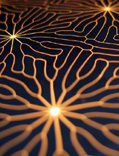
|
Intro:
The production of solar cells across the
globe is experiencing unprecedented
growth. In 2007 production increased
by 70%, as opposed to an average of 40%
in previous years. Today, the installed
worldwide capacity amounts to 10
GigaWatt-peak (GWp). Although this is still
only about 10% of installed wind power in
the world, the other good news is that the
price of solar power is still going down. ‘In
about ten years’ time, the price of solar
will equal the price consumers pay for
conventionally generated electricity,’ says
Paul Wyers, unit manager of Solar Energy
at the Energy research Center of the
Netherlands (ECN). Photo: Detail Solar Panel © Solland Solar |
|
Wind power conquers the globe In: European Energy Review July-August 2008 Read this article in European Energy Review >> (pdf) |
Intro: Europe threatens to be overtaken by China and the US as the leading wind power markets. In fact, China is producing more wind turbines than ever and could even end up supplying the European wind industry. Although Europe’s target of 20% renewables by 2020 seems enormously ambitious, Arthouros Zervos, president of the European Wind Energy Association (EWEA), puts the figure of 180 GW installed capacity into context: ‘It isn’t that ambitious if you compare it to what’s happening on a global scale.’ By that he means the US and China will generate a lot of wind energy in the future, and in the case of China become a major turbine manufacturer. Nowadays, more and more wind turbines or their components bear the label ‘Made in China’. |
|
New in Norway: Floating wind turbines Lees online: European Energy Review May-June 2008  Download pdf >> 166 kb Download pdf >> 166 kb |
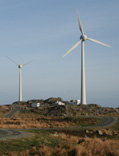
|
Intro:
Compared to other European countries, Norway has very little installed wind power capacity.
But this is about to change. Two different prototypes of a floating wind turbine will soon
be tested in the North Sea, off the south-west coast. Near the island of Utsira,
where wind velocities are high and steady, a consortium of companies want to build Europe’s
first floating wind park. Norway has vast deep sea areas,
and not so much shallow water. That’s why the country is now developing deep-water wind technology.
Another advantage of wind parks in deep water is that they can hardly be seen from the shore, so
there is less public resistence. Photo: Utsira Wind Park © Annemieke van Roekel |
|
De volmaakte rivier In: Wildlife Magazine Maart-april 2008  Download pdf >> 694 kb Download pdf >> 694 kb |
Intro: Vroeger kronkelden de rivieren door het Hollandse landschap en verlegden ze regelmatig hun loop. Tegenwoordig is dat wel even anders. Meanderende rivieren zijn getransformeerd tot vrijwel kaarsrechte, door hoge dijken ingesnoerde waterwegen die zijn voorzien van stuwen en sluizen, talloze kribben en strekdammen. Maar door het afsmelten van gletsjers, meer regenval en een hogere zeespiegel voldoet zo’n ‘genormaliseerde rivier’ niet meer. Klimaatverandering zou wel eens een grote impact kunnen hebben op het toekomstige Nederlandse rivierenlandschap. Interview met Alex van Heezik, auteur van 'Strijd om de rivieren'. |
|
Digital fields help produce more oil In: European Energy Review March-April 2008  Download pdf >> 522 kb Download pdf >> 522 kb |
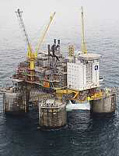
|
Intro:
2014 will be a critical year with respect to global oil demand, as demand
will probably surpass production then. There will not be enough new
oil fields, or new fields will be increasingly located in politically unstable regions.
Oil production will also become more complex, e.g. at deep sea locations, in areas where
the underground geological structure is complicated, or in polar climates.
To win more oil from existing fields, the oil industry has been developing enhanced
oil recovery methods for the past fifty years. Increasing oil production is also realized
by developing digital fields, that combine smart technologies with enhanced
information and communication technology. Photo: Troll field © Helge Hansen / StatoilHydro |
|
'Hydrogen is a choice' In: European Energy Review , January-February 2008  Download pdf >> 194 kb Download pdf >> 194 kb |
Intro: ‘Transport on the basis of hydrogen is a choice. A hydrogen economy will not come about by itself. It is the option with the best outlook in terms of emission reductions and security of supply, but it is also the most difficult to introduce. If we make a conscious choice, it is possible that a considerable number of cars and trucks will be equipped with fuel cells and will use hydrogen in 25 years time,’ says Harm Jeeninga, hydrogen specialist at the Netherlands Energy Research Centre. He stresses that we shouldn't lose sight of the fact that the hydrogen vehicles on the road at the moment are still prototypes and that serialized production is out of the question yet. |
|
Klimaatverandering. Wie doet er wat aan? In: Wildlife Magazine, juli-augustus 2007  Download pdf >> 1,06 mb Download pdf >> 1,06 mb |
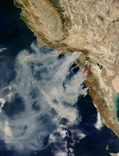
|
Intro: Klimaatverandering is niet alleen lastig voor de mens. Ook planten en
dieren staat heel wat te wachten als de aarde verder opwarmt. Tropische koraalriffen
en amfibieën zullen het zwaarst worden getroffen. Krimp van leefgebieden treedt nu
vooral op in poolgebieden en bergachtige streken. Sommige soorten sterven uit, anderen
migreren. De effecten van recente klimaatverandering op wilde planten en
dieren is al zichtbaar op alle continenten, zo blijkt uit Amerikaans onderzoek. Maar klimaatverandering heeft ook positieve kanten. Op een langere tijdschaal
bezien, is het een impuls voor de evolutie gebleken. Foto: Uitstoot van broeikasgassen tijdens bosbranden © Nasa, MODIS Rapid Response Team, Goddard Space Flight Center |
|
Het klimaat als spelletje In: NRC, 20 januari 2007 Lees dit artikel >> |
Intro: De Vrije Universiteit wil de internationale klimaatarena nabootsen met een interactief computerspel. Het broeikaseffect in hippe vorm, met ruimte voor 'good guys' čn 'bad guys'. De door de VU voorgestelde klimaatgame is een van de zeven genomineerde projecten voor de Academische Jaarprijs 2006/2007. De speler vertegenwoordigt Nederland in de internationale klimaatarena. Om dit te kunnen doen moet hij kennis verzamelen, strategische keuzes maken en onderhandelen aan de hand van concrete situaties, zoals handelen in emissies en investeren in nieuwe technologie. |
|
De oceaan als vuilnisvat In: Wildlife Magazine, november-december 2006  Download pdf >> 1,2 mb Download pdf >> 1,2 mb
|

|
Intro: Almost every Fulmar in the North Sea has plastics in its stomach. 'These pelagic birds eat anything that floats on the ocean's surface, including marine litter like plastics,' says Jan Andries van Franeker, international Fulmar expert, working at IMARES, The Netherlands. Fulmars (Fulmarus glacialis) serve as monitoring instruments for marine litter in the North Sea and Northern Atlantic Ocean, since the Ministers of the North Sea countries decided to start the Ecological Quality Objectives - EcoQO's - in March 2002. A pilot study for monitoring this Fulmar-Litter-EcoQO includes target levels representing a cleaner North Sea. Photo by J.A. van Franeker/IMARES Ga naar de Nederlandse samenvatting >> |
|
'Ik maak me zorgen over het grote aantal fusies' In: Helder, mei 2006  Download pdf >> 235 kb Download pdf >> 235 kb
|
Intro: 'Het is zeer verstandig geweest dat oud-minister Jan Pronk van VROM zich destijds hard heeft gemaakt om de watersector in publieke handen te houden,' zegt algemeen directeur van Waternet, Roelof Kruize. Waternet is sinds 1 januari 2006 het nieuwe waterbedrijf van Amsterdam en het Hoogheemraadschap Amstel, Gooi en Vecht. Kruize vindt winstafdracht aan aandeelhouders - een belangrijk item in de nieuwe concept Waterwet - niet te combineren met de keuze om de waterbranche in publieke handen te houden. Download het volledige artikel hiernaast. Lees ook het artikel 'Water en energie: maatschappelijk verantwoord ondernemen?' >> |
|
Natuur leert leven met vervuiling In: Natuurwetenschap & Techniek, mei 2006  Download pdf >> 315 kb Download pdf >> 315 kb |
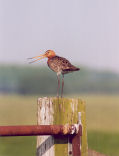
|
Summary: 175.000 sites in rural areas in the Netherlands
are severly polluted. In the Stimulation Program System-oriented Ecotoxicological
Research (SSEO), a selection of rural sites (estuaries, wetland and peat meadows)
has been subject to ecotoxicological research. Effects of heavy metals on animals
are indicated, although natural circumstances such as drought, flooding and food scarcity
may have more effect. The Dutch delta has been polluted by heavy metals in the second part
of the 20th century, when chemicals were imported via the rivers Rhine and Meuse. Photo by Maja Roodbergen: Black-tailed godwit. Read summary in Dutch >> |
|
Brand in de Noordzee! In: Wildlife Magazine, januari/februari 2006  Download pdf >> 1,1 mb Download pdf >> 1,1 mb |
Summary: Adipose (fatty) tissue of dolphins in European seas contains high levels of brominated flame retardants. These chemicals are mainly used in the production of textile, carpet, foam and electronics. Some types bioaccumulate in fatty tissues of mammals. The EU phased out PBB's and Pentamix (a PBDE) was banned recently. The most popular PBDE nowadays is Decamix but NGO's doubt the supposed low toxicity of Deca-BDE and point to the risk of their metabolites. The Dutch institute NIOZ found isomeres of HBCD (esp. abundant in the Irish Sea) to bioaccumulate in sea mammals where they may disrupt thyroid function. However, negative effects on the reproduction of mammals have not been scientifically proven yet and are further investigated in the EU-project Fire. |
|
Zeewater uit de kraan, cover story In: Natuurwetenschap & Techniek, oktober 2005  Download pdf >> Download pdf >>
|
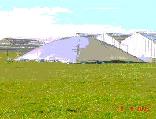
|
Summary: The biggest desalination plant on earth is the Earth itself: every year 100.000 cubic kilometres of sweat water ends up on the continents. According to the Dutch Acacia Institute, we should optimise the use of groundwater by redeveloping traditional storage systems. The Ecological Management Foundation expects desalination to become more important in the near future. A new low-energy desalination method, Memstill, is now being developed in the Netherlands. To meet UN Millennium Goals, low-tech solutions should be developed as well, such as the reward winning WaterPyramide, using solar distillation. Photo by Aqua-Aero WaterSystems: WaterPyramid in The Gambia. Click on the picture for a better view. |
|
Grenen wordt hardhout In: EOS Magazine, april 2005  Download pdf >> Download pdf >>
|
Intro: Voor tropisch hardhout zijn alternatieven op de markt zoals
chemisch verduurzaamd hout en houtproducten die zijn gemaakt van houtvezels
en kunststofgranulaat. Maar het gebruik van chemisch behandeld hout wordt door strengere
milieuwetgeving steeds meer aan banden gelegd. Een alternatief is Platohout.
Het is gestoomd en gebakken vurenhout dat hierdoor de eigenschappen van
hardhout heeft verkregen en er komen geen chemicaliën aan te pas. Lees verder >> |
|
KNMI: 'In 2050 is het ozongat weer dicht' In: EOS Magazine, december 2004  Download pdf >> 1,1 mb Download pdf >> 1,1 mb |
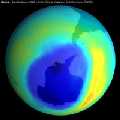
|
Intro: Wetenschappers van het KNMI verwachten
dat de ozonlaag binnen een halve eeuw hersteld zal zijn. De aangroei
van ozon wordt bepaald door een continue uitwisseling van schadelijke
stoffen tussen de stratosfeer en de troposfeer. In afwachting van de eerste resultaten
van de OMI-satelliet, verklaart EOS-magazine hoe ze tot zo'n optimistische voorspelling komen. Foto: Nasa. Meer over ozon en UV-straling op deze site >> Naar artikel 'Een harnas tegen stralen' >> |
|
Megawatts boven water In: EOS Magazine, mei 2003  Download pdf >> Download pdf >>
|
Intro: Steeds grotere windturbines zorgen ervoor dat windtechnologie voor offshore
toepassingen klaar is voor de praktijk. De Noordzee biedt voor windturbineparken een
aantal unieke lokaties. Het is er relatief ondiep en door de hoge windsnelheden wekken windturbines
er veel elektriciteit op. Meer artikelen over windenergie >> |
|
Biologische glastuinbouw: beetje beter voor milieu In: Ekoland, november 2000  Download pdf >> Download pdf >> |
Intro: De milieubelasting die de biologische tomaten-, komkommer- en slateelt veroorzaakt is
lager dan in de gangbare teelt. Dat de biologische glastuinbouw het milieu minder belast komt vooral doordat in de
sector minder gas wordt gestookt en geen chemische bestrijdingsmiddelen worden gebruikt. Lees meer over biologische landbouw op deze site >> |
|
Een wereldzee van groene bloemen In: Intermediair, 9 oktober 1997  Download pdf >> Download pdf >> |
Intro: De bloemensector krijgt oog voor het milieu: de klant wenst een eco-ruiker. Doordat
Nederland de mondiale handel in snijbloemen beheerst, moeten de buitenlandse leveranciers van onze
telers en veilers meedoen. Lees meer over internationale landbouw op deze site >> |
|
Harde milieucijfers blijken boterzacht In: Het Parool, 13 maart 1999  Download pdf >> Download pdf >>
|
Intro: Of olieverf belastender is voor het milieu dan waterverf, hangt af van wat de consument ermee doet. Maar fabrikanten houden daar geen rekening mee. De methode om de milieu-effecten van producten te bepalen blijkt in hoge mate manipuleerbaar, en kan elke gewenste uitkomst leveren. |
|
Nieuwe pogingen tot terugdringen chloor In: Het Parool, 18 mei 1996  Download pdf >> Download pdf >>
|
Intro:De milieubeweging is tegen chloor, de industrie voor. Volgens de milieu-organisaties zijn alternatieven voor chloor wel vaak voorhanden en is een chloorvrije chemie heel goed mogelijk. Voor de chemische industrie zou het een te radicale ommezwaai betekenen om voortaan zonder chloor te werken. |
 Naar artikelen Natuurbescherming Naar artikelen Natuurbescherming© Annemieke van Roekel. Niets van deze website mag worden vermenigvuldigd of openbaar gemaakt door middel van druk, microfilm, fotokopie, plaatsing van teksten en/of afbeeldingen op andere websites of op welke wijze dan ook zonder voorafgaande schriftelijke toestemming van de auteur en de betreffende tijdschriftredacties. [home] [top] [contact] [disclaimer] |